Description
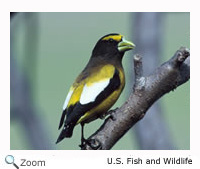 The evening grosbeak is 7-8 inches in length with a wingspan of 12-14 inches. It has a strong, yellowish-green, cone-shaped bill; a short, black tail; and black wings with a white patch. The male has a yellow forehead; a dark brown cap; a lighter brown back; and a yellow breast and rump. The female has a pale gray breast and rump and a darker gray back. The evening grosbeak is 7-8 inches in length with a wingspan of 12-14 inches. It has a strong, yellowish-green, cone-shaped bill; a short, black tail; and black wings with a white patch. The male has a yellow forehead; a dark brown cap; a lighter brown back; and a yellow breast and rump. The female has a pale gray breast and rump and a darker gray back.
Range
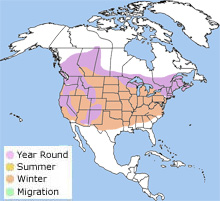 The evening grosbeak breeds across much of southern Canada south to northern California, the Rocky Mountains, the Great Lakes, and the Northeastern United States, including New Hampshire. It winters throughout the United States, except for the southern most parts of the southeastern United States. The evening grosbeak breeds across much of southern Canada south to northern California, the Rocky Mountains, the Great Lakes, and the Northeastern United States, including New Hampshire. It winters throughout the United States, except for the southern most parts of the southeastern United States.
Habitat
The evening grosbeak breeds in coniferous forests. It winters in coniferous, deciduous, or mixed forests. |
|
|
|
Diet
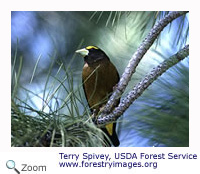 Most of the evening grosbeak's diet is made up of seeds and fruits, but it also eats insects. It prefers the seeds of maple, spruce, pine, fir, and balsam trees.
The evening grosbeak is a common visitor to bird feeders and is especially fond of sunflower seeds. Most of the evening grosbeak's diet is made up of seeds and fruits, but it also eats insects. It prefers the seeds of maple, spruce, pine, fir, and balsam trees.
The evening grosbeak is a common visitor to bird feeders and is especially fond of sunflower seeds.
Life Cycle
 The female evening grosbeak lays 3-4 eggs in a nest of pine needles, roots, and twigs, and lined with grass, lichen, and moss. The nest is built by the female and is usually placed high in a tree. The female incubates the eggs for 12-14 days. The male brings the female food while she incubates the eggs. Both the male and the female feed the chicks. The chicks fledge when they are around two weeks old, but their parents continue to feed them for a few weeks. Male and female pairs may have two broods a year. The female evening grosbeak lays 3-4 eggs in a nest of pine needles, roots, and twigs, and lined with grass, lichen, and moss. The nest is built by the female and is usually placed high in a tree. The female incubates the eggs for 12-14 days. The male brings the female food while she incubates the eggs. Both the male and the female feed the chicks. The chicks fledge when they are around two weeks old, but their parents continue to feed them for a few weeks. Male and female pairs may have two broods a year.
Behavior 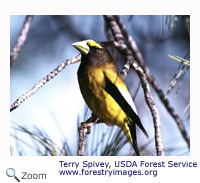 The evening grosbeak feeds in noisy flocks. It is a nomadic bird, if the food supply is low in an area, it will move in search of a better location. Some eastern populations migrate south in the winter. Other populations may migrate from high altitudes to lower altitudes. The evening grosbeak feeds in noisy flocks. It is a nomadic bird, if the food supply is low in an area, it will move in search of a better location. Some eastern populations migrate south in the winter. Other populations may migrate from high altitudes to lower altitudes.
|

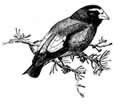

 The evening grosbeak breeds across much of southern Canada south to northern California, the Rocky Mountains, the Great Lakes, and the Northeastern United States, including New Hampshire. It winters throughout the United States, except for the southern most parts of the southeastern United States.
The evening grosbeak breeds across much of southern Canada south to northern California, the Rocky Mountains, the Great Lakes, and the Northeastern United States, including New Hampshire. It winters throughout the United States, except for the southern most parts of the southeastern United States.


